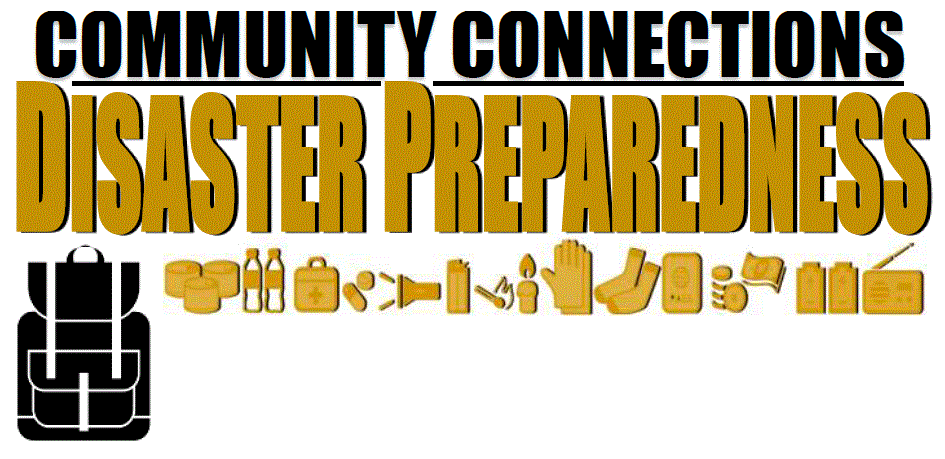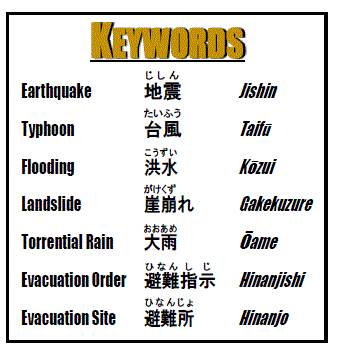 Community Connections
- August 2018
Community Connections
- August 2018
Community Connections is a column written by a Hiroshima City CIR, in which ways of making connections with people or local communities are introduced.
What is a C.I.R. (Coordinator for International Relations)?
A Coordinator for International Relations, or CIR for short, is a participant on the JET Programme who assists local government offices in international exchange at the local level.
DISASTER PREPAREDNESS
By Andrew Dempster

No one knows how a natural disaster is going to unfold. We can predict when and where a typhoon might hit, but the extent of the damage caused by rainfall, the chances of landslides and the fallout from those events are impossible to know. Starting July 5th, torrential downpours across central and western parts of the country caused flash flooding and landslides, and evacuation orders were issued for millions of people.
Most information in the event of a disaster is issued in Japanese and without easily understood information, the entire ordeal can be quite unsettling for those who do not understand Japanese. Having links with your community is vital in times of disaster. Whether that be with your neighbours, colleagues or friends, having the reassurance from those around you is important. Be sure to know who to contact for help and advice, and do not hesitate to ask your neighbours what to do if you are unsure.

One thing you can do to help mitigate the impact a disaster has on your life is to be as prepared as possible. The national and regional governments recommend that you prepare a lightweight survival kit somewhere easily accessible for use in the event of an emergency which contains the following items:
- □ Food:
- Three days’ worth of non-perishable, easy-to-prepare food.
- □Water:
- 2-3l per person per day for consumption, cooking, washing.
- □ First aid kit:
- Common household medicines, disinfectant, bandages, plasters, prescription medication, etc.
- □ Flashlight (Lighting):
- A light source in the case of power outages. Flashlights, headlamps, candles and lighters are all acceptable.
- □ Thick gloves, shoes and socks:
- Work gloves and footwear that is easy to walk in and that will protect against hazards such as broken glass.
- □ IDs, contact information, cash:
- Keep a written note of contact information and some loose change and bills in your bag, and make sure your passport, residence card and other important documentation are close to hand so that you can bring them along if you need to evacuate.
- □ Spare batteries and chargers:
- Batteries and solar chargers, etc.
- □ Radio:
- Radios can be a vital source of information. Those with a hand crank generator that also feature a flashlight and charging ports are particularly convenient.
- □ Other items:
- Wet wipes, towels, sanitary items, changes of clothes, prescription medicines, spare glasses/other sight/hearing aids.
Japan is particularly prone to natural disasters: earthquakes, tsunami, typhoon, landslides, volcanic eruptions. There is no shortage of potential dangers. Being prepared in advance is vital. Know who to contact; know which websites to consult for information; know where your closest evacuation site is; prepare your survival kit. You don’t know when you’ll need it.
More information can be found in the Emergency and Disaster Prevention Information section of the Hiroshima Daily Life Guidebook for International Residents which can be accessed through the following link: http://www.city.hiroshima.lg.jp/www/contents/1274162987368/files/2018en.pdf
The Peace Culture Foundation provides updates regarding the recent disaster which are translated into Chinese, English, Portuguese and Spanish and can be accessed through our website: http://www.pcf.city.hiroshima.jp/ircd/index.html
The Japan Meteorological Agency website offers almost real-time updates in English, as well as information regarding evacuation advisories and orders: https://www.jma.go.jp/jma/indexe.html

 [pdf,89KB,1page]
[pdf,89KB,1page]